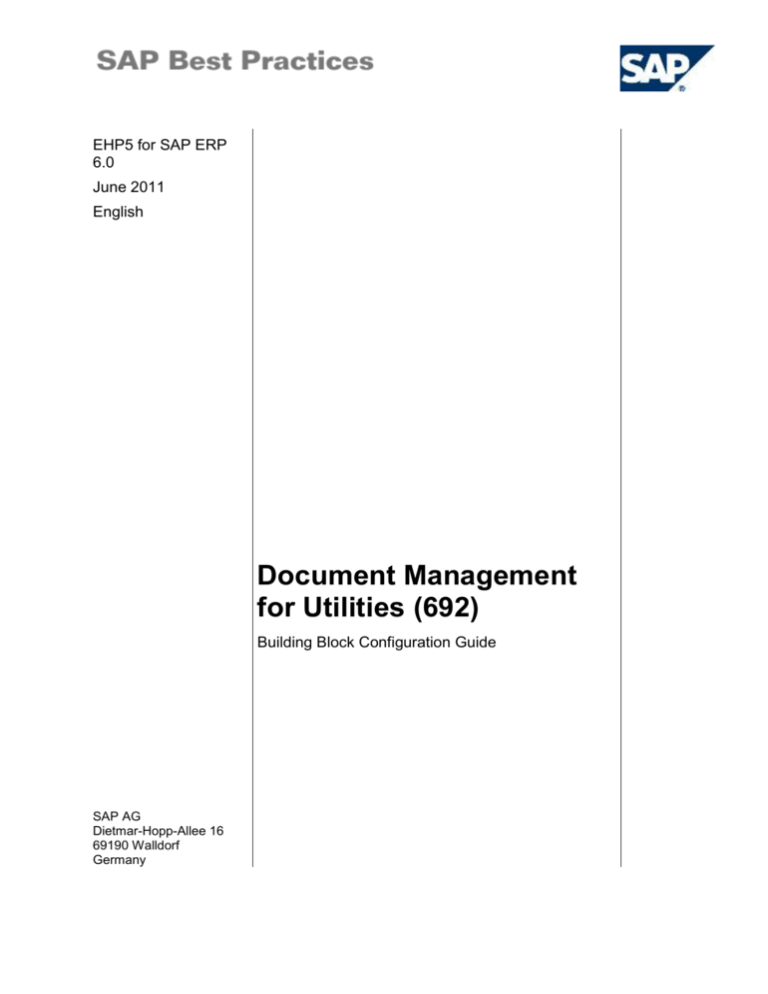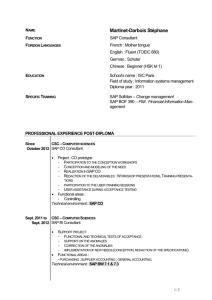
EHP5 for SAP ERP
6.0
June 2011
English
Document Management
for Utilities (692)
Building Block Configuration Guide
SAP AG
Dietmar-Hopp-Allee 16
69190 Walldorf
Germany
SAP Best Practices
Document Management for Utilities (692): Configuration Guide
Copyright
© 2011 SAP AG. All rights reserved.
No part of this publication may be reproduced or transmitted in any form or for any purpose without the
express permission of SAP AG. The information contained herein may be changed without prior notice.
Some software products marketed by SAP AG and its distributors contain proprietary software
components of other software vendors.
Microsoft, Windows, Excel, Outlook, and PowerPoint are registered trademarks of Microsoft Corporation.
IBM, DB2, DB2 Universal Database, System i, System i5, System p, System p5, System x, System z,
System z10, System z9, z10, z9, iSeries, pSeries, xSeries, zSeries, eServer, z/VM, z/OS, i5/OS, S/390,
OS/390, OS/400, AS/400, S/390 Parallel Enterprise Server, PowerVM, Power Architecture, POWER6+,
POWER6, POWER5+, POWER5, POWER, OpenPower, PowerPC, BatchPipes, BladeCenter, System
Storage, GPFS, HACMP, RETAIN, DB2 Connect, RACF, Redbooks, OS/2, Parallel Sysplex, MVS/ESA,
AIX, Intelligent Miner, WebSphere, Netfinity, Tivoli and Informix are trademarks or registered trademarks
of IBM Corporation.
Linux is the registered trademark of Linus Torvalds in the U.S. and other countries.
Adobe, the Adobe logo, Acrobat, PostScript, and Reader are either trademarks or registered trademarks
of Adobe Systems Incorporated in the United States and/or other countries.
Oracle is a registered trademark of Oracle Corporation.
UNIX, X/Open, OSF/1, and Motif are registered trademarks of the Open Group.
Citrix, ICA, Program Neighborhood, MetaFrame, WinFrame, VideoFrame, and MultiWin are trademarks
or registered trademarks of Citrix Systems, Inc.
HTML, XML, XHTML and W3C are trademarks or registered trademarks of W3C ®, World Wide Web
Consortium, Massachusetts Institute of Technology.
Java is a registered trademark of Sun Microsystems, Inc.
JavaScript is a registered trademark of Sun Microsystems, Inc., used under license for technology
invented and implemented by Netscape.
SAP, R/3, SAP NetWeaver, Duet, PartnerEdge, ByDesign, SAP BusinessObjects Explorer,
StreamWork, and other SAP products and services mentioned herein as well as their respective logos
are trademarks or registered trademarks of SAP AG in Germany and other countries.
Business Objects and the Business Objects logo, BusinessObjects, Crystal Reports, Crystal Decisions,
Web Intelligence, Xcelsius, and other Business Objects products and services mentioned herein as well
as their respective logos are trademarks or registered trademarks of Business Objects Software Ltd.
Business Objects is an SAP company.
Sybase and Adaptive Server, iAnywhere, Sybase 365, SQL Anywhere, and other Sybase products and
services mentioned herein as well as their respective logos are trademarks or registered trademarks of
Sybase, Inc. Sybase is an SAP company.
All other product and service names mentioned are the trademarks of their respective companies. Data
contained in this document serves informational purposes only. National product specifications may
vary.
These materials are subject to change without notice. These materials are provided by SAP AG and its
affiliated companies ("SAP Group") for informational purposes only, without representation or warranty
of any kind, and SAP Group shall not be liable for errors or omissions with respect to the materials. The
only warranties for SAP Group products and services are those that are set forth in the express warranty
statements accompanying such products and services, if any. Nothing herein should be construed as
constituting an additional warranty.
.
© SAP AG
Page 2 of 7
SAP Best Practices
Document Management for Utilities (692): Configuration Guide
Icons
Icon
Meaning
Caution
Example
Note
Recommendation
Syntax
External Process
Business Process Alternative/Decision Choice
Typographic Conventions
Type Style
Description
Example text
Words or characters that appear on the screen. These include field
names, screen titles, pushbuttons as well as menu names, paths and
options.
Cross-references to other documentation.
Example text
Emphasized words or phrases in body text, titles of graphics and tables.
EXAMPLE TEXT
Names of elements in the system. These include report names,
program names, Transaction codes, table names, and individual key
words of a programming language, when surrounded by body text, for
example, SELECT and INCLUDE.
Example text
Screen output. This includes file and directory names and their paths,
messages, source code, names of variables and parameters as well as
names of installation, upgrade and database tools.
EXAMPLE TEXT
Keys on the keyboard, for example, function keys (such as F2) or the
ENTER key.
Example text
Exact user entry. These are words or characters that you enter in the
system exactly as they appear in the documentation.
<Example text>
Variable user entry. Pointed brackets indicate that you replace these
words and characters with appropriate entries.
© SAP AG
Page 3 of 7
SAP Best Practices
Document Management for Utilities (692): Configuration Guide
Contents
Document Management for Utilities: Configuration Guide ........................................................ 5
1
Purpose .............................................................................................................................. 5
2
Preparation ......................................................................................................................... 5
2.1
2.1.1
3
Prerequisites ............................................................................................................ 5
Building Blocks..................................................................................................... 5
Configuration ...................................................................................................................... 5
3.1
Defining Document Type/Document Status ............................................................. 5
3.2
Defining data carrier ................................................................................................. 6
3.3
Define Data Carrier - Identify frontend computers ................................................... 7
© SAP AG
Page 4 of 7
SAP Best Practices
Document Management for Utilities (692): Configuration Guide
Document Management for Utilities:
Configuration Guide
1 Purpose
This configuration guide provides the information you need to set up the configuration of this
building block manually.
If you do not want to configure manually and prefer an automated installation process using
eCATTs and BC Sets, use the Building Block Installation Assistant.
2 Preparation
2.1 Prerequisites
2.1.1
Building Blocks
Before you start installing this building block, you must install prerequisite building blocks. For
more information, see the Building Block Prerequisite Matrix for Baseline. The matrix (an
Excel file) is linked on the solution's DVD/website in one of the following two locations:
Content Library
Site Map
3 Configuration
3.1 Defining Document Type/Document Status
Use
In this step, you define the settings for the document type.
Procedure
1. Access the activity using one of the following navigation options:
Transaction code
SPRO
IMG menu
Cross-Application Component Document Management
Control Data Define Document Types
2. On the Change View Define document types: Overview screen, check the following
entries exist or not:
Field name
Document type
Description(EN)
Entry 2
YU2
Work clean Document
3. If the entries do not exist, choose New Entries to make the entries according to following
table:
Field
nam
e
© SAP AG
Do
c.
typ
Descripti
on(EN)
Version
assign.
Arch
iv.
Auth
Cha
ng.
Doc
Int.
numb
er
Ext.
num
ber
Vers.
No.
Incr.
Num
ber
Exit
File
Size
Page 5 of 7
SAP Best Practices
Document Management for Utilities (692): Configuration Guide
e
2nd
Entry
YU
2
Work
clearance
Documen
t
selected
.
s
range
rang
e
sele
cted
sele
cted
02
01
2
MCD
OKZN
R
99999
99
4. Choose Save.
5. On the Change View Define document types: Overview screen, select document type
YU2 by highlighting the row. Double-click Define language-dependent descriptions. When
a screen appears on the right, make the following entries:
Field name
Description
User action and values
Language
EN
Doc. type
YU2
Doc. Type
desc
Work clearance Document
Comment
6. Double-click Define document status in the Dialog Structure window, and choose New
Entries to maintain entries according to the following table:
Field
name
Doc. type
Doc.
Status
Status text
Abbrev.
Entry 1
YU2
AA
Work request
WR
Entry 2
YU2
FR
Released
RE
Released Ind.
Select
7. Choose Define Object Link, and make entries according to the following table:
Field name
Description
User action and values
Document
Type
YU2
Object
WCAHE
Screen no.
500
Additional
Functions
X
Comment
8. Choose Save.
9. Choose Exit.
Result
Document type defined.
3.2 Defining data carrier
Procedure
1. Access the activity using one of the following navigation options:
Transaction code
SPRO
IMG menu
Cross-Application Component Document Management
General Data Define Data Carrier
© SAP AG
Page 6 of 7
SAP Best Practices
Document Management for Utilities (692): Configuration Guide
2. Choose Enter to confirm the Information dialog box with the message “Caution: The table
is cross-client”.
3. On the Change View Define data carrier type “archive: Overview screen, double-click
Define data carrier type “archive” in the browse window Dialog Structure. Choose New
Entries, and make the following entry:
Field name
Description
User action and values
Type
PC
Description
Local PC
Online
Selected
Comment
4. Choose Save.
5. Choose Exit.
3.3 Define Data Carrier - Identify frontend computers
Use
This activity is done independently of the storage system that is run.
Procedure
1. Access the activity using one of the following navigation options:
Transaction code
SPRO
IMG menu
Cross-Application Components Document Management
General Data Define Data Carrier
2. Choose Enter to confirm the Information dialog box with the message “Caution: The table
is cross-client”.
3. On the Change View “Define data carrier type” archive””: Overview screen, double-click
the folder Define data carrier type "server, front end" in the Dialog Structure in the left part.
4. On the Change View “Define data carrier type” server, front end”””: Overview screen,
choose the line with the following entry you created in the last step.
5. Double-click Identify frontend computers in the Dialog Structure in the left part.
6. Choose Default entry.
7. In the subsequent screen, check the following entries:
FrontendComputer
Data carr. type
Netw. address
Description
Default
PC
DEFAULT
Default for local PC
8. Choose Save.
Result
You have identified front end computers.
© SAP AG
Page 7 of 7









